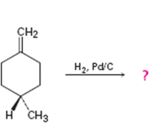
a)

Interpretation:
Whether the reaction shown will result in an optically active product is to be stated.
Concept introduction:
The catalytic hydrogenation is a heterogeneous process that occurs with syn stereochemistry. Both the hydrogens add from the same face of the double bond from the catalytic surface.
To state:
Whether the reaction shown will result in an optically active product.
b)

Interpretation:
Whether the reaction shown will result in an optically active product is to be stated.
Concept introduction:
The
To state:
Whether the reaction shown will result in an optically inactive product.
c)

Interpretation:
Whether the reaction shown will result in an optically active product is to be stated.
Concept introduction:
During ozonolysis the double bond in
To state:
Whether the reaction shown will result in an optically active product.
Trending nowThis is a popular solution!

Chapter 8 Solutions
ORGANIC CHEMISTRY-EBOOK>I<
- Influence of salt concentrations on electrostatic interactions 2 Answer is 2.17A why not sure step by step please What is the Debye length in a concentrated salt solution with an ionic strength of 2.00 mol/l? Assume room temperature, i.e. T= 298 K, and provide your answer as a numerical expression with 3 significant figures in Å (1 Å = 10-10 m).arrow_forwardThe name of the following molecule is: Νarrow_forwardThe table shows the tensile stress-strain values obtained for various hypothetical metals. Based on this, indicate which is the most brittle and which is the most tough (or most resistant). Breaking strength Elastic modulus Material Yield strength Tensile strength Breaking strain A (MPa) 415 (MPa) (MPa) (GPa) 550 0.15 500 310 B 700 850 0.15 720 300 C Non-effluence fracture 650 350arrow_forward
- Please correct answer and don't used hand raitingarrow_forwardThe table shows the tensile stress-strain values obtained for various hypothetical metals. Based on this, indicate which material will be the most ductile and which the most brittle. Material Yield strength Tensile strength Breaking strain Breaking strength Elastic modulus (MPa) (MPa) (MPa) (GPa) A 310 340 0.23 265 210 B 100 120 0.40 105 150 с 415 550 0.15 500 310 D 700 850 0.14 720 210 E - Non-effluence fracture 650 350arrow_forwardPlease correct answer and don't used hand raitingarrow_forward

 Organic ChemistryChemistryISBN:9781305580350Author:William H. Brown, Brent L. Iverson, Eric Anslyn, Christopher S. FootePublisher:Cengage Learning
Organic ChemistryChemistryISBN:9781305580350Author:William H. Brown, Brent L. Iverson, Eric Anslyn, Christopher S. FootePublisher:Cengage Learning Organic Chemistry: A Guided InquiryChemistryISBN:9780618974122Author:Andrei StraumanisPublisher:Cengage Learning
Organic Chemistry: A Guided InquiryChemistryISBN:9780618974122Author:Andrei StraumanisPublisher:Cengage Learning


